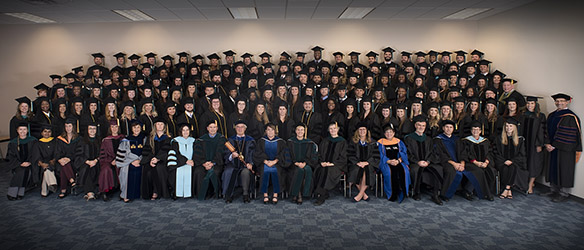
Dr. Erin Schwier, OTD, EDD, OTR/L, associate professor and program director of the occupational therapy programs at USAHS’ campus in San Marcos, California
There’s an intense demand for the next generation of occupational therapists (OTs) – and a wealth of rewarding occupational therapy (OT) careers, including opportunities to work with the neurodiverse community. According to the U.S. Bureau of Labor Statistics (BLS), OT employment is expected to grow 14 percent between 2021 and 2031.
“This has become more evident than ever with the shortage [labor-wise] of occupational therapists,” said Erin Schwier, OTD, EDD, OTR/L.
Dr. Schwier is an associate professor and program director of the occupational therapy programs at the University of St. Augustine for Health Sciences (USAHS) campus in San Marcos, California. She hopes to help close the shortage gap by preparing future OTs. She’s committed to inspiring students to embrace the unique profession and its ability to help people regain their lives.
Occupational therapy (OT) “enables people of all ages to participate in daily living,” according to the American Occupational Therapy Association (AOTA).
Schwier focuses on the neurodiverse community and how OTs can tailor their training to people with varying levels of cognitive ability, particularly those on the autism spectrum. As a longtime OT with over two decades of professional experience, Schwier is passionate about working with adolescent and young adults with neurocognitive and behavioral disorders.
She was recently consulted by Forbes Magazine and contributed to a conversation about OT’s critical influence on neurodiverse people.
Schwier has a powerful and positive effect on her OT patients as she empowers them to live meaningful lives. She told Forbes, “As an occupational therapist, I get to help them discover who they are, what they can contribute to society, and how they can live their best life.”


Schwier even decided to shift her work from clinical practice to academia because she prides herself on helping students to find their purpose and become skilled occupational therapy practitioners.
“I’m excited to be in the classroom helping students discover their passions and reveal how occupational therapy can be applied,” she said, “At the [university], our curriculum focuses on helping occupational therapists develop problem solving, clinical reasoning, and innovative forward-thinking to be able to serve individuals well and advocate for our profession, especially in areas that may not be so prevalent.”
She explains how occupational therapy encourages patients to accept neurodiversity and see their differences as an ability rather than a limitation. She teaches students to follow a three-step therapy process: identify someone’s strengths, enhance those strengths and turn those strengths into action.
OTs support autistic patients in managing sensory processing and/or sensory integration dysfunction. “An occupational therapist’s superpower is activity analysis,” said Schwier. OTs evaluate the situation, along with environmental, psychological, social and neurological impact, to determine the best approach and help an individual accomplish their goals.
Furthermore, occupational therapy is linked to accessibility and assistive technology for people with autism. According to Forbes, “People are accessing techniques to make the other parts of their lives more accessible. As OT is focused on everyday life, that technology plays such a vital role in daily living means an autistic person may find ways to better interact with the panoply of screens they look at for hours on end.”
Schwier sees OT as an essential path to “a fruitful life” for neurodiverse people. For aspiring OTs, this creates a range of opportunities for a promising and fulfilling career.
Ready to launch your OT educational journey? Discover USAHS’ immersive OT programs, and apply today.
Learn more about Dr. Schwier’s occupational therapy discussion and read the Forbes article.






